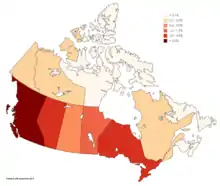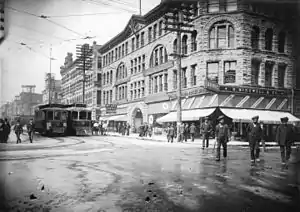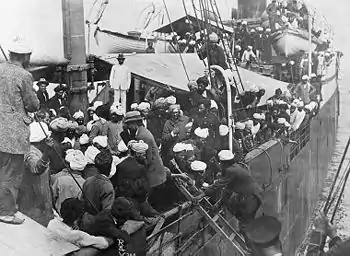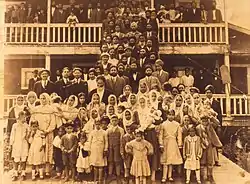Punjabi Canadians
Punjabi Canadians (Punjabi: ਪੰਜਾਬੀ ਕਨੇਡੀਅਨ/پنجابی کینیڈین) number nearly 700,000 and account for roughly 2% of Canada's population. Their heritage originates wholly or partly in the Punjab, a region in northern South Asia, encompassing India and Pakistan.
ਪੰਜਾਬੀ ਕਨੇਡੀਅਨ پنجابی کینیڈین | |
|---|---|
 Punjabi ancestry % in Canada (2016) | |
| Total population | |
| 668,240[1][lower-alpha 1] 1.9% of the total Canadian population (2016) | |
| Regions with significant populations | |
| British Columbia • Ontario • Alberta | |
| Languages | |
| Canadian English • Punjabi and its dialects • Canadian French • Hindi • Urdu | |
| Religion | |
| Majority: Minority: | |
| Related ethnic groups | |
| Indian Canadians • Pakistani Canadians • Punjabi Americans |
Punjabis first arrived in Canada during the late 19th century to work in the forestry industry. Primarily concentrated in the western province of British Columbia, the Punjabi population initially peaked in 1908 before an ensuing period of population decline and stagnation followed. In the mid 20th century Canadian immigration laws were relaxed, fostering rapid population growth into the present day.
Today, the largest Punjabi communities in Canada are situated in the province of British Columbia, concentrated in Vancouver, and the province of Ontario, particularly in Toronto.
| Part of a series on |
| Punjabis |
|---|
 |
|
Punjab portal |
History
Late 19th century

.jpg.webp)
In 1897, the first persons of Punjabi origin visited British Columbia. They were soldiers transiting from India to the United Kingdom during the Diamond Jubilee of Queen Victoria.[2] The Punjabis ultimately became the first South Asian-origin group to settle in Canada.
Early 20th century
In 1900, the population of Punjabis in Canada increased to 100.[2] By 1906, this number increased to 1,500. The vast majority were Sikhs and came from Hoshiarpur, Jalandhar, Amritsar, Ferozpur, and Ludhiana.[3] At the turn of the century the Mayor of Vancouver did not permit cremation, so when the first Sikh died in 1907 he could not be cremated in the Vancouver city limits. Christian missionaries did not permit him to be buried with whites. Even though the missionaries promoted burial, the Sikhs instead cremated the man in a distant wilderness. This prompted Sikhs to establish their own religious institutions.[4]
Initially, Punjabis were guaranteed jobs by agents of big Canadian companies like the Canadian Pacific Railway and the Hudson's Bay Company. Overcoming their initial reluctance to go to these countries due to the treatment of Asians by the white population, many young men chose to go, having been assured that they would not meet the same fate. They were British subjects and Canada was a part of the British Empire.[5]
However, upon arrival to British Columbia, the Punjabi immigrants faced widespread racism by the local white Canadians. Most of the white Canadians feared workers who would work for less pay, and that an influx of more immigrants would threaten their jobs. As a result, there were a series of race riots that targeted the Punjabi Sikh immigrants, who were beat up by mobs of angry white Canadians, though often met with retaliation.[6] Nevertheless, during the most infamous anti-Asian riot in BC history (Anti-Oriental Riots of 1907), Punjabis were spared as they remained indoors.[7]
The continued tensions caused the Punjabi population to fall from a high of 4,700 in 1907, to less than 2,000 by 1914.[8] In 1908 the British Columbia government passed a law preventing Indian men from voting. Because eligibility for federal elections originated from provincial voting lists, East Indian men were unable to vote in federal elections.[9]
Most early Punjabi settlers in Canada worked in the agricultural and forestry sectors in British Columbia.[10] Punjabis became the majority ethnic group within the sawmill workforce in British Columbia by 1907, as many Anglo Canadians had disinterest in being sawmill workers."[11]

Punjabis were later faced by one of the most iconic racial exclusion acts in Canadian history. In 1914, The Komagata Maru, a steamliner carrying 376 passengers from Punjab docked in Vancouver. Of them, 24 were admitted to Canada, but the other 352 passengers were not allowed to disembark in Canada, and the ship was forced to return to India. The passengers comprised 337 Sikhs, 27 Muslims and 12 Hindus.[12]
Mid 20th century

By 1923, Vancouver became the primary cultural, social, and religious centre of Punjabi Canadians as it had the largest ethnic Indian population of any city in North America.[13]
The Punjabi population in Canada would remain relatively stable throughout the mid 20th century as the exclusionary immigration policies practiced by the Canadian government continued. However, a shift began to occur after World War Two. The Canadian government re-enfranchised the Indo-Canadian community with the right to vote in 1947. In 1967 all immigration quotas based on specific ethnic groups were scrapped in Canada, thus allowing the ethnic Punjabi population in Canada to grow rapidly thereafter. Most continued to settle in the Lower Mainland.
As many Punjabis worked in the forestry industry, Northern British Columbia began to see a rise in Punjabi immigration in the 1960s. Prince George, the economic centre of Northern BC, became a secondary hub for early Punjabi immigration.[14]
However, Vancouver remained the centre of Punjabi immigration through the mid 20th century. In the 1960s, ethnic Punjabis began moving to all areas in the Lower Mainland, however two concentrations soon developed: South Vancouver and Burnaby.[15] Out of these two newly formed ethnic enclaves, it was South Vancouver which began to flourish as the Punjabi Market was soon founded in the late 1960s.
Later in the 1970s, Punjabi populations began appearing in Delta, Richmond, and Surrey. Vandalism against houses owned by Indo-Canadians and a Sikh gurdwara occurred in the 1970s, especially in 1974-1975 in Richmond.[16]
Late 20th century to present
By the 1980s, the traditional Punjabi immigration patterns began to shift. Ontario soon became an important centre of immigration to Canada. Large Punjabi populations began to appear across the Greater Toronto Area. Later in the 1990s, Alberta became another important immigration destination for Punjabis. Most concentrated in Edmonton and Calgary.
Today, the Punjabi population of Canada is 668,240 with the largest community still located in British Columbia. In addition, Punjabi is the third most spoken language of the Parliament of Canada.[17]
Demographics
The largest Punjabi populations in Canada are located in British Columbia and Ontario. Alberta and Quebec are also home to significant populations with Saskatchewan and Manitoba featuring small but rapidly growing Punjabi communities.
| Province | Punjabis in 2016[18] | % 2016 | Punjabis in 2011[19] | % 2011 |
|---|---|---|---|---|
| 244,485 | 5.4% | 213,315 | 4.9% | |
| 282,065 | 2.1% | 238,130 | 1.9% | |
| 90,485 | 2.3% | 62,815 | 1.8% | |
| 22,900 | 1.8% | 12,555 | 1.1% | |
| 17,860 | 0.2% | 14,480 | 0.2% | |
| 8,300 | 0.8% | 3,250 | 0.3% | |
| 1,010 | 0.1% | 800 | 0.1% | |
| 485 | 0.1% | 115 | 0.0% | |
| 205 | 0.0% | 115 | 0.0% | |
| 185 | 0.1% | 15 | 0.0% | |
| 150 | 0.4% | 105 | 0.3% | |
| 105 | 0.3% | 20 | 0.0% | |
| 15 | 0.0% | 15 | 0.0% | |
| 668,240 | 1.9% | 545,730 | 1.7% |
British Columbia
In Metro Vancouver, 5.5% of residents reported speaking Punjabi at home, as of 2011. 21.3% of Surrey residents speak it as their primary language at home.
Ontario
In Ontario, Punjabi Canadians are prevalent in the Greater Toronto Area, especially in Scarborough, Markham, Mississauga, Brampton, and Ajax.[20]
Religion
During the early stages of Punjabi immigration to Canada, most pioneers were of the Sikh faith.[21] Today, Punjabi Canadians remain mostly Sikhs , however also include large numbers of Muslims and Hindus and smaller numbers of Christians.
Notable people
- Qaiser Ali, cricket player
- Sajida Alvi, academic
- Suroosh Alvi, journalist and filmmaker
- Anita Anand, politician
- Deepak Anand, politician
- Jazzy B, singer
- Harry Bains, politician
- Navdeep Bains, politician
- Nav Bhatia, businessman
- Umar Bhatti, cricket player
- Bardish Chagger, politician
- Ranjit Cheema, gangster
- Rizwan Cheema, cricket player
- Paul Chohan, former field hockey player
- Herb Dhaliwal, former politician
- Sukh Dhaliwal, politician
- Anju Dhillon, politician
- Ujjal Dosanjh, former politician
- Tarek Fatah, journalist
- Kash Heed, former police chief and politician
- Qurram Hussain, singer
- Bindy Johal, gangster
- Rupi Kaur, author
- Jujhar Khaira, ice hockey player
- Iqra Khalid, politician
- Obby Khan, former football player
- Rukhsana Khan, writer
- Wajid Khan, politician
- Kamal Khera, politician
- Akshay Kumar, Bollywood actor
- Sunny Leone, Bollywood and adult actress
- Jinder Mahal, professional wrestler
- Deepa Mehta, film director
- Omar Majeed, film director and producer
- Nav, rapper and singer
- Zarqa Nawaz, film director/producer and author
- Musarrat Nazir, singer/actress
- Wally Oppal, former politician
- Balraj Panesar, field hockey player
- Sukhi Panesar, field hockey player
- Shafiq Qaadri, politician
- Ali Amjad Rizvi, journalist and political activist
- Raj Saini, politician
- Jag Sahota, politician
- Ruby Sahota, politician
- Harjit Sajjan, politician
- Nick Sandhu, former field hockey player
- Alex Sangha, social worker and documentary film producer
- Ramesh Sangha, politician
- Bob Saroya, politician
- Zaib Shaikh, actor
- Munir Sheikh, economist
- Maninder Sidhu, politician
- Sonia Sidhu, politician
- Moe Sihota, former politician
- Gurv Sihra, wrestler
- Harv Sihra wrestler
- Gagan Sikand, politician
- Buckam Singh, former soldier
- Harnarayan Singh, journalist and sports announcer
- Jagmeet Singh, politician
- Jasmeet Singh, comedian
- Lilly Singh, comedian
- Mewa Singh, former activist
- Tiger Jeet Singh, wrestler
- Naweed Syed, scientist
- Tim Uppal, politician
- Adnan Virk, sports announcer
- Saad Bin Zafar, cricket player
See also
References
- "Census Profile, 2016 Census, Canada". Government of Canada, Statistics Canada. 2017-02-08. Retrieved 28 December 2018.
- Walton-Roberts, Margaret. 1998. "Three Readings of the Turban: Sikh Identity in Greater Vancouver" (Archive). In Urban Geography, Vol. 19: 4, June. - DOI 10.2747/0272-3638.19.4.311 - Available at Academia.edu and at ResearchGate. p. 316.
- Lal, p. 29.
- Hans, p. 221-222.
- Singh, Khushwant (Feb 26 – Mar 12, 1961). "The Ghadr Rebellion". Illustrated Weekly of India: Feb 26 – Mar 12. Archived from the original on 24 March 2014. Retrieved 2 February 2014.
- "SOME SIGNIFICANT MOMENTS IN SIKH-CANADIAN HISTORY" (Archive). ExplorAsian. Retrieved on November 10, 2014.
- Century of Struggle and Success The Sikh Canadian Experience 13 November 2006
- Pg. 79. White Canada Forever. By W. Peter Ward. 2002. McGill, Quebec, Canada. ISBN 978-07735-2322-7
- Nayar, The Punjabis in British Columbia, page 15.
- "Country Brief – Canada" (Archive). Ministry of Overseas Indian Affairs. p. 4/7. Retrieved on October 21, 2014. "Emigrants from India today enjoy success in all fields within the economy while there are some concentration in British Columbia in agriculture and forestry."
- Nayar, The Punjabis in British Columbia, p. 28. "In fact, early in the twentieth century, when many Chinese and Japanese men were working in sawmills, lumber labour had become associated with ethnicity."
- "Komagata Maru".
- Das, p. 20-21 (Archive).
- "The Indo-Canadian Community" (Archive). Report on the Quality of Life in Prince George. 1997. University of Northern British Columbia. p. 254 (PDF 3/17). Retrieved on October 19, 2014.
- Nayar, The Sikh Diaspora in Vancouver, p. 327.
- Johnston, Hugh, p. 7.
- Firstpost (3 November 2015). "Oye hoye! Punjabi is now the third language in Parliament of Canada". Firstpost.
- "Census Profile, 2016 Census Canada [Country] and Canada [Country]".
- "NHS Profile, Canada, 2011".
- "Census: Punjabi-speaking population growing in Metro Vancouver". Vancouver Sun. October 24, 2012.
- Nayar, The Punjabis in British Columbia, p. 9. "It is interesting to note that, in the BC Lower Mainland (Vancouver and surrounding municipalities, including Burnaby, New Westminster, Richmond, and Surrey), Sikhs raised outside the Punjab refer to themselves as Punjabi and use the term interchangeably with "Sikh," understanding the two as synonymous."
- (Only includes the number of total Punjabi language speakers and doesn't include native English, Hindi and Urdu language speakers.)